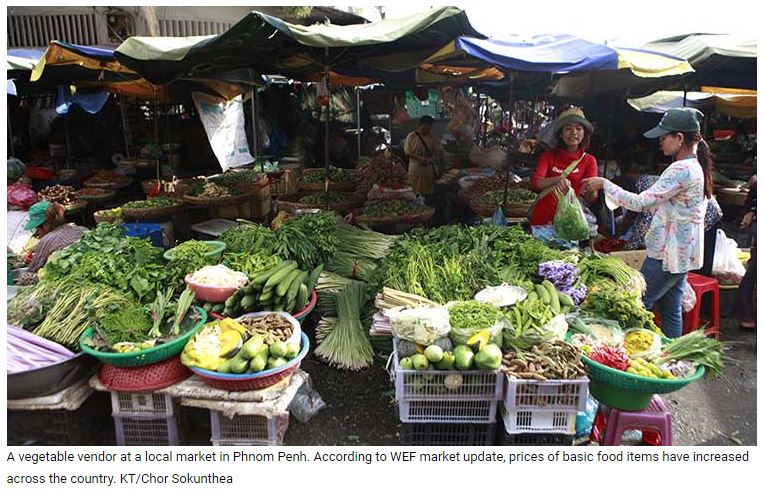Cambodia: Prices of basic food items up, more in urban areas
The overall cost of basic food items, part of the WFP basic food basket, in Cambodia showed an upward trend in October compared with September and the same month of the last year, and it was higher in urban areas than in the rural part of the country.
The cost of WFP basic food basket in October increased by 7 percent over the previous month and 5 percent year-on-year, which is equivalent to 116,536 riels ($28.4) per person per month. In urban areas, the cost of basic food basket stayed higher than in rural areas, according to the WEF market update for October, which was released on 29 November.
The Market & Seasonal Monitoring Update is prepared by the United Nations World Food Programme (WFP) in partnership with the Agricultural Marketing Office (AMO) of the Ministry of Agriculture, Forestry and Fisheries (MAFF) of Cambodia.
In urban areas, it was up 7.3 percent month-on-month at $28.9 and 6.7 percent at $27.8 compared to the same month of the last year, according to update.
The basic food basket comprises key commodities, like mixed rice, snakehead fish, pork, duck egg, vegetable oil, sweet potato, and morning glory, which contribute to the minimum energy requirement of 1,937 kcal per person per day.
Food inflation in Cambodia is expected to be 4.50 percent by the end of this quarter, according to Trading Economics (TE) global macro models and analysts expectations. In the long-term, the Cambodia’s food inflation is projected to trend around 3.20 percent in 2023 and 3 percent in 2024, according to the econometric models.
To understand the impact of global food and fuel crisis on food prices on the availability of food and access to markets in Cambodia, the WFP with the AMO monitors the retail and the wholesale prices of key food commodities in 56 urban and rural markets across the Kingdom.
Together they talk to around 250 traders and market chiefs every two weeks to understand the local market situation from the perspective of prices and access. Market chiefs are also interviewed to assess market functionality, including supply and demand issues.
While prices of most food commodities in the basket remained stable month-on-month, morning glory reported a 38 percent (month-on-month) spike, probably because of large-scale flooding in September and early October.
The BFB was adopted from WFP’s minimum expenditure basket study in Cambodia.
While the FAO global food price index remained unchanged from September, global cereal prices rose in October – including for wheat, maize, and rice – amidst renewed uncertainties. As the global economic slowdown intensifies, commodity prices are expected to ease in 2023 and 2024, but they will remain at historically high levels compared to their average over the past five years, says the report.
The global food crisis has been partially aggravated by food trade restrictions put in place by several countries to increase domestic supply and reduce prices. As of October 21, 2022, 20 countries have initiated 25 food export bans, and 8 have implemented 12 export-limiting measures, according to the UN World Food Programme and Cambodia AMO report.
Source: https://www.khmertimeskh.com/501197063/prices-of-basic-food-items-up-more-in-urban-areas/


 English
English




